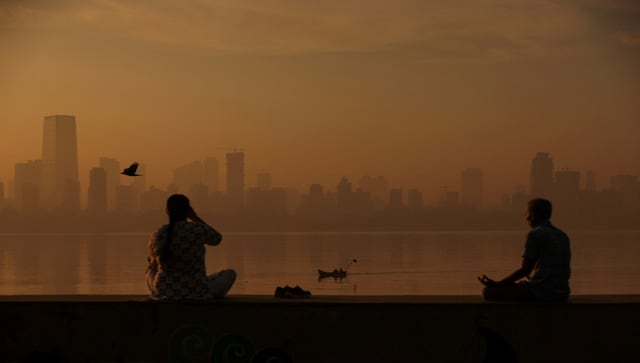Smoggy City: Why Mumbai’s air quality is going the Delhi way
Smoggy City: Why Mumbai’s air quality is going the Delhi way

Mumbai’s bad air continues to be a cause of concern. Engulfed in smog, Maharashtra’s capital was among the top 10 most polluted cities across the world, according to Swiss group IQAir’s data on Thursday (9 November) at 10.30 am.
After light rains lashed parts of the city a day back, the air quality improved a bit to settle in the ‘moderate’ category this morning, with the overall Air Quality Index (AQI) at 103. Even as several places witnessed ‘satisfactory’ air quality, some recorded ‘very poor’ AQI.
Mumbai has been reeling from poor air days since October when AQI went over 300 in some of the western suburbs. There were even days last month when the city had worse air quality than Delhi.
What is behind the air pollution crisis of India’s financial capital? Let’s take a closer look.
Cocktail of reasons
There is not just one reason that can be blamed for Mumbai’s air pollution crisis. However, some factors may help us understand better why the city’s air quality dips nearly every year around winter.
Mumbai, which is surrounded by the sea on three sides, has typically benefited from its location as strong winds disperse most of the pollutants in the air. But this October, a slew of elements rendered that geographical advantage ineffective, leading to pollutants getting trapped, according to an expert.
“After the monsoon receded, the coastal winds, which typically aid in pollutant dispersion, became slow. Additionally, there was a significant temperature differential between the Sahyadri hills and the plain region, near Navi Mumbai. The winds descending from the hills were considerably cooler than those in the plains, giving rise to a vortex effect. In this region, airborne dust was trapped and subsequently pushed towards Mumbai. Given that surface winds in Mumbai were already stagnant, particulate pollution found itself trapped within the city for prolonged periods,” Gufran Beig, the founder of System of Air Quality and Weather Forecasting and Research (SAFAR) and Chair Professor in National Institute of Advanced Studies (NIAS), told IndiaSpend.
VIDEO | Visuals from Marine Drive, #Mumbai as the city continues to grapple with air pollution. #mumbaiairquality pic.twitter.com/RwIk2KU5pQ
— Press Trust of India (@PTI_News) November 9, 2023
Some have also attributed the deteriorating air quality to the ongoing construction across the city. There are around 6,000 sites in Mumbai that are witnessing construction presently. Green activists have also pointed fingers at the metro construction, which has shrunk many busy roads to half in the city for the last five years, as per a Times of India (TOI) report.
Vehicular emissions have only exacerbated the pollution problem. Mumbai has the highest density of private cars in India – 650 per km of road. “Our roads have been halved, vehicles crawl as a result and take double the time to reach their destination, spewing more particulate matter into the air,’’ pulmonologist Dr Sanjeev Mehta told TOI.
#WATCH | Maharashtra: Visuals from Mumbai’s Chhatrapati Shivaji Terminus (CSMT) and Marine Drive area as the Air Quality Index dips to ‘Very Poor’ category.
(Visuals shot at 7:20 am) pic.twitter.com/OPQKcWjDrD
— ANI (@ANI) November 9, 2023
Last year, Mumbai saw its longest spell of bad air — from November to January. Experts say the La Nina conditions could have had a role to play in the city’s air quality. However, while there is no La Nina this year, one of the reasons for the increase in air pollution in the city could be due to the October heat and a lingering monsoon, TOI reported.
Speaking to Indian Express, SN Tripathi, a professor at IIT Kanpur and one of India’s leading experts on air pollution, explained: “There is no ambiguity. Long-term trends show a clear decline in Mumbai’s air quality, particularly in the last one decade. The reasons are quite obvious. There is a lot more economic activity, more vehicles, more construction, more consumption and more emissions. And there is no matching effort to mitigate the impacts.”
Impact on health
Mumbai’s receding air quality has led to a rise in people complaining about respiratory issues, especially those in vulnerable groups. A paediatric hospital told TOI that the number of children with respiratory problems has jumped to 30 per cent in a month.
A recent survey by LocalCircles found that four in five families in Mumbai have at least one member suffering from sore throat or cough. Of the nearly 7,000 respondents, 44 per cent have experienced burning eyes due to pollution, while 39 per cent reported runny nose or congestion and 28 per cent complained of difficulty in breathing or asthma.
According to NDTV, a hospital in Parel, which saw its patients with respiratory issues double in the last six months, has set up a special Intensive Respiratory Care Unit.
ALSO READ: Delhi, Mumbai see bad air days again: Are authorities doing enough to curb pollution?
Latest steps by authorities
The authorities in Mumbai have ramped up a crackdown on those violating air pollution norms.
The Maharashtra Pollution Control Board (MPCB) and the Brihanmumbai Municipal Corporation (BMC) issued notices on Wednesday (8 November) to various infrastructure developers engaged with Coastal Road and Metro rail projects, reported Indian Express.

The BMC reportedly demolished nine chimneys belonging to gold and silver smelting businesses in Kalbadevi and Zaveri Bazar area in the last few days. The Mumbai civic body’s C-ward office has also ordered the closure of 13 “unauthorised” furnaces in Sakinaka, located in the Andheri East area.
Meanwhile, Maharashtra cabinet minister Deepak Kesarkar has urged citizens to refrain from bursting firecrackers during Diwali and instead celebrate the festival by lighting lamps.
His comments come after the Bombay High Court limited the time for bursting firecrackers in the city on Diwali to only 3 hours, between 7 pm to 10 pm.
What's Your Reaction?



























































